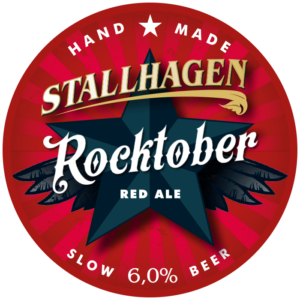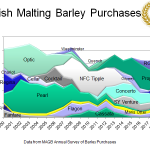 Me? I love Rocktober. No, not that beer. That’s just for show. A middling beer from the middle of the Baltic. I am talking about the month. Yes, that’s where we are all now. Rocktober. When recreations start to shift indoors. Fun. And if I call it that I will forget for a moment it’s also when all the leaves die and the ice first forms. Better to rock. Speaking of death… wasn’t it great when Facebook died this week – even if only for a few hours? Some may live in an upside-down world but, really, Facebook is a cesspool of anti-democratic and anti-science lies lies lies… and Twitter is just fun even if chippy… but blogs are sweet and charming. Web 2.0 > Web 3.0. So welcome aboard for another week. What’s going on?
Me? I love Rocktober. No, not that beer. That’s just for show. A middling beer from the middle of the Baltic. I am talking about the month. Yes, that’s where we are all now. Rocktober. When recreations start to shift indoors. Fun. And if I call it that I will forget for a moment it’s also when all the leaves die and the ice first forms. Better to rock. Speaking of death… wasn’t it great when Facebook died this week – even if only for a few hours? Some may live in an upside-down world but, really, Facebook is a cesspool of anti-democratic and anti-science lies lies lies… and Twitter is just fun even if chippy… but blogs are sweet and charming. Web 2.0 > Web 3.0. So welcome aboard for another week. What’s going on?
First up, this looks like an interesting hour on “Under-Attenuated: Women, Beer History Studies and Representation” at the Chicago Brewseum’s Beer Culture Summit on the first weekend of November with a few familiar faces:
… while beer history studies is a newer field recognized in the academic landscape, it’s no surprise that it too is a male dominated area of study. Archaeologist and historian Dr. Christina Wade, archivist Tiah Edmunson-Morton, and organizer, attorney, author and documentarian Atinuke “Tinu” Akintola Diver discuss the unique experiences (both successes and roadblocks) they have seen throughout their careers researching, collecting and documenting beer and brewing history in a man’s world. This session is moderated and hosted by co-founder of the Albany Ale Project, Craig Gravina.
Nice to be referenced: “co-“! There are a whack of other topics, too, with loads of interesting speakers with loads of different points of view. No wonder the “Males on Ales Through the Ages” conference scaled way back.
Next, the Mudge himself wrote of the state of pubs and cask ale in the UK this week:
Heavy-handed Covid safety protocols largely seem to have gone by the board, although a few Perspex screens at bars and pointless one-way systems remain. I have walked out of one pub where it was clear that the full works of safety theatre were being applied, and declined to go in another because of a sign outside saying the same, but those were isolated examples. In general, rural and semi-rural pubs seem keener to retain restrictions than urban ones, maybe because they feel they have a captive market who can’t take their trade elsewhere so easily.
Note: The editorial board of A Good Beer Blog lean heavily towards the screen and mask ethos but we are a full service blog of many opinions. And we just don’t want to die of Covid-19 personally. Mask up and take your needles.
“Ancestral beer“? It’s the new thing that turns out isn’t actually a thing at all:
“If you want to sell something on a large scale, you’ve got to have a standard flavor that’s replicable from one bottle to the next,” Juárez said. “Whereas, with a wild beer, no two are ever the same.” Her quest: to bring the old world into modern times. “We’ve brought flavors that were being left behind back to life,” she said. Ancestral beer is determined by the type of yeast used as the main ingredient…
Apparently the proponents of ancestral beer have slept through the micro and home brewing movements entirely. The phrase “it’s not off, it’s Belgian style!” ring any bells?
Josh Noel has been doing a great job in the Chicago Tribune covering the union busting ways at Goose Island:
Several people active in the union drive say they don’t doubt the company was under financial strain at the time. But they also believe Goose Island used the layoffs to target leading union activists and to finish off their efforts. According to current and former employees, the idea of unionizing Goose Island has withered away.
Then Josh linked to the Guys Drinking Beer social media feed where a brewery tour manager seemed to be facilitating a creep making pervy moves on a fellow member of staff. He “told the employee to let said harasser kiss her… apparently gave the harasser her cell phone number.” Now that is an actual grade A asshole.* Remember that next time some beer writing bootlicking hack drools over the keyboard next time there is a Bourbon County Stout junket needing a press release parroting.
Suddenly, I don’t feel well. Why oh why? Oh… it’s this.
Of higher note, I came across a fascinating paper this week, “Marckalada: The First Mention of America in the Mediterranean Area (c. 1340)” which discusses the new first reference to the Americas in southern European literature. Here’s the only bit of the sort I was really after:
Further northwards there is the Ocean, a sea with many islands where a great quantity of peregrine falcons and gyrfalcons live. These islands are located so far north that the Polar Star remains behind you, toward the south. Sailors who frequent the seas of Denmark and Norway say that northwards, beyond Norway, there is Iceland; further ahead there is an island named Grolandia, where the Polar Star remains behind you, toward the south. The governor of this island is a bishop. In this land, there is neither wheat nor wine nor fruit; people live on milk, meat, and fish.
See that – wine. Or actually no wine. Now, it’s written by an Italian for an Italian crowd but what I am looking for is some contemporary reference to ale drinking in the Viking North American experience. Not in this paper…
 What is this poll even about? Best comment was the one to the right…
What is this poll even about? Best comment was the one to the right…
Liam wrote about Coopers, Ireland’s first beer brand:
The most important point perhaps is that I think that Cooper may have been the first Irish – or at least Irish brewed – beer to be marketed with a brand, jingle (I know I am taking liberties here…) and editorial advert? I am not aware of any others that existed this early anywhere else on these islands in fact, although I have not overly researched it to be fair. I would guess that it was certainly the first trademarked Irish-brewed beer …
First brand? Well, consumer product branding as we know it only came about in around 1800. When adjectives like “cream” started getting added to descriptors. When the breweries rather than retailers posted most of the notices in the papers. (Somewhere I had a paper that explained it all… where is that…)
Finally, Bloomberg is reporting** that ABInBevBigCo is considering getting its Teuronic off:
Anheuser-Busch InBev NV Chief Executive Officer Michel Doukeris is considering a sale of some German beer brands it has owned for decades as the world’s largest brewer aims to prune less profitable businesses and trim debt. The brewer is exploring the sale of labels such as Franziskaner Weissbier, Hasseroeder and Spaten, and the portfolio could fetch about 1 billion euros ($1.2 billion), people familiar with the matter said, asking not to be identified discussing confidential information.
Interesting (if really badly edited) stat in that article: “Although Germany brews about a quarter of all beers originating from the continent, it exports less of the drink than both the Netherlands and Belgium…” Is that “either” or “combined”? Who knows?!? Thanks Mr. Editor.
Done. For more check out the updates from Boak and Bailey mostly every Saturday and from Stan now on a regular basis again every Monday, plus more with the weekly Beer Ladies Podcast, and at the weekly OCBG Podcast on Tuesday and sometimes on a Friday posts at The Fizz as well. There is a monthly sort of round up at The Glass. There is more from the DaftAboutCraft podcast, too. And the Beervana podcast. And sign up for Katie’s weekly newsletter, The Gulp, too. And check out the Atlantic Canada Beer Blog‘s weekly roundup. Plus follow the venerable Full Pint podcast. And Fermentation Radio with Emma Inch. The AfroBeerChick podcast as well! And also look at Brewsround and Cabin Fever. And Ben has his own podcast, Beer and Badword – when he isn’t in hiatus as at the mo, more like timeout for rudeness! And remember BeerEdge, too, and The Moon Under Water.
*Unlike one former beer writer when apparently drunk. Note also, however, that the Beer Culture Summit’s final event is at the Goose Island Brewpub. Watch out!
**Or as GBH would say after reading the same article: “GBH sources have stated that Anheuser-Busch InBev NV Chief Executive Officer Michel Doukeris is considering a sale of some German beer brands…” Again, no one responded to GBH’s inquiries.



















